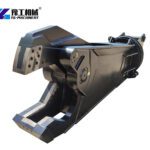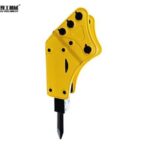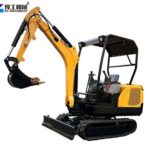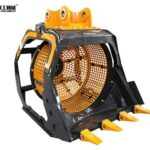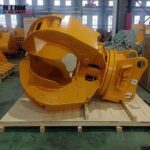Excavator concrete saw is an attachment designed to turn an excavator into a powerful cutting machine capable of slicing through reinforced concrete, asphalt, and other hard materials. Unlike traditional concrete cutting methods, which can be labor-intensive and require specialized crews, an excavator concrete saw allows for faster, more efficient, and more precise cuts. The saw blade is typically mounted at the front of the excavator arm and can be operated hydraulically, giving the operator precise control over the depth and speed of the cut. Excavator concrete saws are particularly useful in large-scale construction and demolition projects where precision and speed are critical. These saws can cut through thick concrete walls, floors, or slabs, making them indispensable in road construction, trenching, and industrial demolition.
Components of the Excavator Rock Saw
Hydraulic Motor: Converts excavator hydraulic flow into blade rotation.
Diamond Blade: Industrial-grade segmented rim for cutting reinforced concrete.
Adjustable Boom: Allows precise depth and angle control.
How Does a Hydraulic Concrete Saw Work?
The working process of the excavator saw begins when the excavator’s hydraulic system delivers high-pressure fluid to the saw’s motor, spinning the diamond blade at high speed. Operators use the excavator’s joystick controls to position the blade vertically or horizontally, making it ideal for plunge cuts, slotting, and slab removal.
Top 6 Benefits of Using an Excavator Saw Attachment
1. Unmatched Power: Outperforms handheld saws in speed and depth.
2. Enhanced Safety: Operators stay cab-protected during cutting.
3. Versatility: Handles bridge decking, foundation removal, and trenching.
4. Cost Efficiency: Reduces labor and project timelines.
5. Precision: Laser-guided options ensure millimeter accuracy.
6. Durability: Built to withstand abrasive materials and extreme conditions.
Wide Applications of Concrete Saw for Excavator
1. Demolition Projects: Rapidly dismantle concrete structures without explosives.
2. Roadwork: Create expansion joints or remove damaged pavement sections.
3. Utility Installation: Cut trenches for pipelines or electrical conduits.
4. Mining: Modify concrete barriers or access mineral deposits.
How to Choose the Right Excavator Rock Saw for Your Project
Choosing the right excavator concrete saw depends on several factors:
- Project Size and Scope: Consider the scale of the project. For smaller projects, a compact, walk-behind saw may be sufficient. For larger-scale projects, such as roadwork or large-scale demolition, a heavy-duty model with greater cutting depth and power may be necessary.
- Material Type: Depending on whether you’re cutting through standard concrete, reinforced concrete, or asphalt, you may need a saw with a different blade design or power capacity. Make sure to choose a model that can handle the specific material you’re working with.
- Depth and Angle of Cut: If you require cuts at varying depths or angles, choose a saw with adjustable depth and angle controls. Some excavator concrete saws can cut vertically or horizontally, offering greater flexibility.

